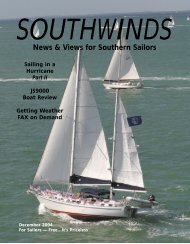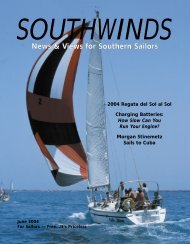Read PDF - Southwinds Magazine
Read PDF - Southwinds Magazine
Read PDF - Southwinds Magazine
Create successful ePaper yourself
Turn your PDF publications into a flip-book with our unique Google optimized e-Paper software.
Loopers pose for a photo at a recent Fall AGLCA rendezvous held<br />
just off the Tennessee-Tom Bigbee Waterway in Rogersville, AL, at<br />
Joe Wheeler State Park.<br />
loopers. After motoring into Joe Wheeler Marina for the rendezvous,<br />
Bob and Donnell from Grand Haven, MI, spoke<br />
with us about their mast, or lack of one, and how they have<br />
managed throughout their time on the loop.<br />
Because these sailors are members of AGLCA and participate<br />
in the daily digest web forum, they were well aware<br />
of the need to step their mast to complete the next leg of the<br />
loop. They decided to have the mast trucked to a destination<br />
further south. I asked why truck instead of carrying the mast<br />
in an X frame on deck. They chuckled and said their mast<br />
height is 62 feet above the water, is keel-stepped and may be<br />
65 feet or longer. That would cause a lengthy overhang on<br />
both the bow and stern of their 44-foot sailboat, over 10 feet<br />
at each end of the boat! Keep in mind that a mast in a frame<br />
will come straight down the center of the boat, across the<br />
cabin and cockpit, making helm duty more fun than usual. So<br />
Bob and Donnell coordinated with nine other members of<br />
AGLCA through email and telephone and agreed to be a part<br />
of a group pricing to remove and truck their masts.<br />
Throughout the first third of their loop, they have met or spoken<br />
with over 20 other sailboats looping who agree; shipping<br />
their mast is the best method of dealing with the low bridges,<br />
locks and marinas. So before heading to Chicago, they met<br />
the other sailors in Holland, MI, to remove their mast and<br />
poof! They’re a flotilla of low-profile powerboats.<br />
Of course, I asked how many boat units are needed to<br />
accomplish this surgery of sorts. The large group of nine<br />
boats sharing in the expenses of the truck reduced that fee<br />
significantly. Their boatyard expense was also lessened<br />
because Bob and Donnell were comfortable disconnecting<br />
all the electrical connections, saving in that labor cost. The<br />
boatyard price to remove the mast and load onto the truck<br />
was about $450 and their partial expense of the truck transportation<br />
was $420 to Mobile, AL. Add the cost of a boatyard<br />
in Mobile to step the mast, and Bob and Donnell plan<br />
to tune the rigging themselves.<br />
What about the running lights, radio antenna and<br />
anchor light once the mast is gone Simple cruiser engineering<br />
provided a cabin mounted VHF antenna while the<br />
masthead and anchor light now reside atop a PVC pipe<br />
mast. The radar was kept aboard to protect it instead of<br />
trucking it on the mast and risking damage along the way.<br />
So, without a mast they now have a sleek low-profile<br />
trawler that can ease under almost any bridge without<br />
radioing for an opening. They rely purely on their single<br />
diesel engine for propulsion. Their Island Packet has tankage<br />
for 250 gallons of water and 160 gallons of diesel. Their<br />
See us at the<br />
Miami Strictly<br />
Sail Boat Show<br />
34 January 2013 SOUTHWINDS www.southwindsmagazine.com

















